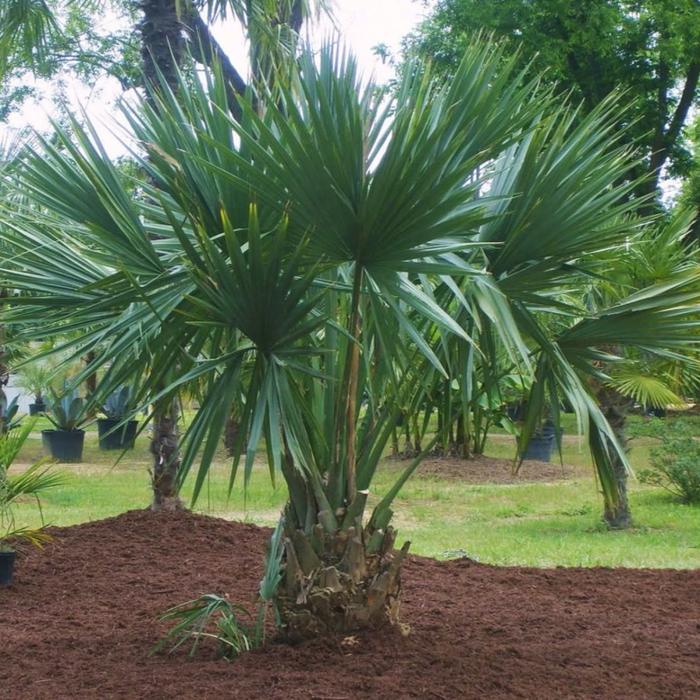
If you've ever been captivated by a poolside landscape filled with graceful Pindo Palms, you might find yourself wondering how stunning they would look in your own front yard. If you live in Georgia and find yourself drawn to this idea, keep reading—we’ll share the reasons why your dream landscape might not be as ideal as it seems.
The Pindo Palm (butia capitata), also known as the Jelly Palm, is a slow-growing palm native to South America, specifically Brazil and also Argentina and Uruguay.
Easy to maintain and highly drought-tolerant, this palm thrives in both full sun and shady areas. Its slow growth rate makes it perfect for container planting, allowing it to stay in the same pot for years without needing to be transplanted.
It is known for its graceful, arching blue-green fronds and its ability to tolerate cooler temperatures compared to other tropical palms.
But all that glitters is not gold, and experience has taught us that what works on paper doesn’t always work in practice.
Despite its beauty and resilience, the Pindo Palm comes with challenges that make it a less-than-ideal choice for Georgia landscapes, and even more so when it comes to winter.
First things first: Some official numbers from the US Department of Agriculture
What does the official USDA Hardiness Zone map say about Georgia’s average annual minimum winter temperatures?
Georgia falls within zones 7A to 9A, meaning winter temperatures can range from 0°F to 30°F. That’s a pretty wide range, isn’t it?
Let’s focus on the Atlanta area: the southern outskirts generally fall within zones 8A and 8B (10°-20°F) whereas the northern areas, closer to the mountains, fall into zones 8A and 7B cold hardiness (5°-15°F)
If you want to make check your specific zone, you can easily look up your ZIP code on the official map below:
Now, what to expect from Pindo Palms’ cold hardiness?
It is said that Pindo Palms are good to be planted in zones 8-11 and tolerate up to 20° F. In some cases, mature specimens can survive brief dips below 10°F.
Although they are considered the most cold-hardy of all the feathery-frond palms, if you belong to the northern hemisphere of the Capital City, you might want to start reconsidering your choice of a Pindo Palm for your back yard.
If you belong to the other half of the group, don’t breathe a sigh of relief just yet—we still have some important facts for you to know.
Our own experience planting Pindo Palms in Georgia: What We Learned
Atlanta Palms planted Pindo Palms for our customers beginning in early 2021 and all throughout 2023, confident that their reputation as cold-hardy palms would hold up. And for a while, they did. They stood tall, adding that perfect tropical touch to the landscape. But then came December 2022, roughly around Christmastime—and with it, an unforgiving cold wave.
By the time temperatures returned to normal, reality hit hard: many of the Pindo Palms didn’t make it. Customers were frustrated, and understandably so. We took responsibility, replacing all that were reported as dead. Lesson learned, right? Well… not quite.
Fast forward to December 2023, and history repeated itself. Another brutal freeze, another wave of complaints, and another round of replacements. At this point, it was clear—Pindo Palms were just not cut out for Georgia’s unpredictable winters.
So, what did altantapalms.com do in 2024? We got smarter. This time, we swapped Pindos for truly cold-hardy palms—ones that could handle the worst winter could throw at them. No more wishful thinking, no more costly do-overs. Just the right palms for the right place.
Pindo Palms in Georgia: A Risky Choice in a Changing Climate
It’s not just about bad luck or a fluke cold snap—climate change is a real factor here. While Pindo Palms may seem like a suitable option for some parts of southern Georgia, the truth is that as summers get hotter, winters are also becoming more extreme. The same shifts in climate that bring blistering heat in the summer are also making winter cold snaps more intense, making it harder for certain plants to thrive.
What seemed like the perfect palm for your landscape might not stand up to these extreme temperature swings.
Has Your Palm Tree Dream Gone Cold?
There's still hope for your tropical paradise. While Pindo Palms may not be the best fit for Georgia’s extreme weather, the good news is that there are still plenty of other palms that can thrive here.
And after almost making you lose all hope, we’ve got more good news to share: You can find the most cold-hardy palms in our online store or physical location, ready to transform your yard into the tropical paradise you’ve been dreaming of—no matter the weather! So you can rest easy, even during the coldest months.
But Wait—Which Palms Can Actually Handle Atlanta’s Cold?
We’ll introduce you to the top three most cold-hardy palms that can thrive in your landscape.

Also known as the Sabal minor, is one of the most distinguished freeze-resistant and cold hardy palms under six feet. It has evergreen fan-like fronds coming out of a single base that grows into a trunk.
The Dwarf Palmetto grows in any type of soil; it’s even been known to grow in marshes or arid, steep mountain areas.
This is the perfect palm to plant under a taller tree or palm but also thrives as a stand-alone palm.
Dwarf Palmettos are sturdy, adaptable, and resistant to diseases and pests. When it comes to cold-hardiness, they thrive in zones 7–11 and can withstand temperatures as low as 10°F, with occasional drops to 0°F.
If you live in Georgia and are looking for an evergreen palm under 6 feet, the Dwarf Palmetto is your perfect match!
But I want those tall palms like the ones in Caribbean pictures!
Rest easy, there’s a palm for every taste and style. For those dreaming of a tropical paradise, we present the Windmill Palm, one of the most cold-hardy tall palms you can grow in Atlanta, bringing that Caribbean vibe right to your front yard.
The Windmill Palm (Trachycarpus fortunei), originally from Eastern Asia, also known as a Chinese Fan Palm is a slow grower that can reach heights of up to 20-40 feet.

Windmill palms are pest and disease-resistant, and require minimal effort in terms of care and maintenance.
Windmill Palms thrive in zones 7–11, though they’ve been spotted surviving in even colder regions. They can handle steady temperatures around 10°F, with brief drops to 0°F. However, younger Windmills need some extra care in the cold, as they’re more vulnerable to damage. The good news? As they mature, they toughen up each winter—so it’s not uncommon to see larger Windmill Palms standing strong in places where temperatures dip well below 10°F.
If we haven’t convinced you yet, hold onto your seats—because we’re about to introduce you to a palm that can make your tropical oasis a reality.
Needle Palm (Rhapidophyllum hystrix)

We like saving the best for last so if you ended up here, you really deserve to know that the Needle Palm is the most cold hardy palm in the world, having been recorded surviving temperatures as low as -5 F.
It has glossy green fan-like fronds that end in a pointy needle-like leaf, hence its name. It grows like a shrub from a single base that stays close to the ground, never growing a trunk.
Although this slow-growing palm is great in the cold, it still needs hot summers to survive. Feeling like you just found the missing piece, right? Atlanta brings the heat—and the cold. And this palm is built for both.
The Needle Palm thrives in moist environments and makes an excellent companion palm. It’s perfect for mimicking a bush in the landscape or for planting under the canopy of larger palms or trees. This hardy, low-maintenance palm provides year-round greenery with minimal effort, looking great through every season.
Having revealed all the mysteries, if you’ve read through and still need some guidance, we’ve got you covered: If you live in Georgia and you're still unsure which palm will thrive in your yard, don't hesitate to reach out to us.
As experts in cold-hardy palms, we’ll help you make the best choice for your space.







